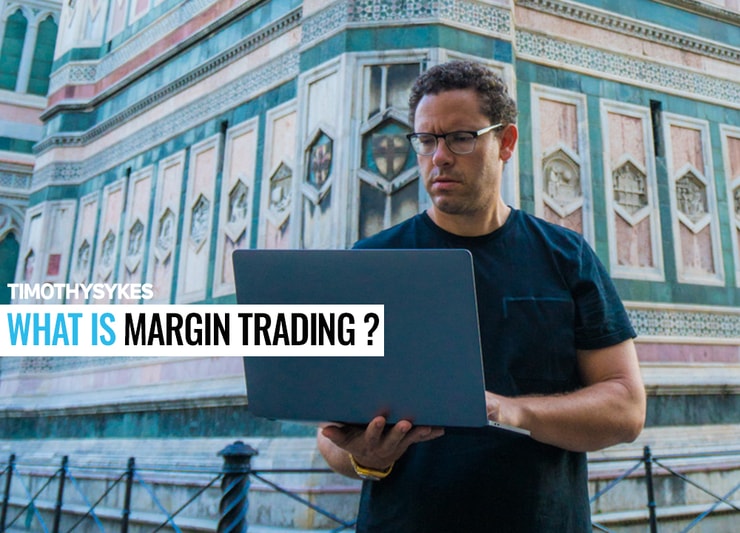Margin trading can be a double-edged sword for traders. It can grant you access to additional trading capital, but it comes with some very serious risks.
Wait … what is margin trading?
Margin trading is a type of trading where you borrow assets from your broker so you can take bigger trade positions, and in an ideal world, earn bigger profits. Sound too good to be true? It usually is.
The same borrowed funds that can equal profits can also result in devastating losses.
Let’s get one thing straight: Margin trading isn’t a cure for cash woes. In fact, it can create even more cash issues in the long term, and I don’t suggest it at all for new traders.
Whether you ever plan on margin trading, it’s useful to understand what it is and how it’s done. In this post, I’ll cover the basics of margin trading — how it works, pros and cons, and what can happen in the best and worst case scenarios.
Table of Contents
What Is Margin Trading?
Margin trading, also called ‘trading on margin,’ is a way of borrowing assets from your broker using your own account as equity. With this increased amount of capital, you can execute bigger trades, with the hope of earning bigger profits.
What Is a Margin Account?
Margin trading starts with a margin account. So what’s that?
In trading, there are two key types of accounts: cash accounts and margin accounts. Let’s briefly discuss each:
Cash account: This is the type of account most new traders are familiar with. It’s kind of like your personal bank account for trading.
The capital in the account amounts to what you have deposited, and that’s how much buying power you have in the stock market. So, if you have a cash account with $5K, that’s how much cash you have available for trading.
Margin account: With a margin account, you have the ability to take out loans from your broker based on the amount that you put into the account.
A margin account is kinda like a home equity line of credit, where you can borrow an amount based on the value of your house. And as with home equity, your margin buying power goes up based on the amount in your account.
Not every broker offers margin accounts, and not every margin account is the same. Some may require specific minimums and that you meet certain criteria, such as a particular net worth. For specific details on how to open a margin account, talk to your broker.
How a Margin Account Works
With a margin account, your broker will offer you access to an agreed-upon amount of funds based on your balance. The ratio of funds available in relation to the funds you’ve deposited will depend on the broker.
It could be a 1–1 ratio, meaning that they’ll match the amount in your account. But it could be another amount, such as a 2–1 or a 4–1 ratio. In forex trading, the ratios tend to be higher — it can be as high as 100–1!
The ratio represents how many dollars the broker is willing to loan you based on your deposit amount.
FOR EXAMPLE: If you open a margin account with $5K and your broker offers a 1–1 ratio, you’d have your money plus $5K available from the broker. That would be a total of $10,000 of trading money. If they offer a 4–1 ratio margin account, you’d have access to $20,000 for trading.
No, brokers don’t do this out of the goodness of their hearts. For the privilege of holding a margin account, you pay interest on what you borrow. That’s called the margin rate. So whether you win or lose with the money you use to trade, you still have to pay the interest.
How Does Margin Trading Work?
How does margin trading differ from a trade from a cash account? Let’s take a look.
FOR EXAMPLE: Say you have $5,000 in your cash account. With this balance, you can buy 500 shares of Stock X at $10 per share. Now, say the stock price goes up 20%. You earned a nice $1,000 profit.
Now, if you use a margin account with a 1–1 ratio instead, you could buy double the amount of shares, and the same trade would net you $2,000.
The idea is that if you have access to more money to trade with, you have the potential to earn more profits. And in this example, even after paying back the borrowed funds and interest, your gain is still higher than if you just made the trade using the funds in your cash account.
This hypothetical is a best-case scenario in margin trading. Of course there’s a flip side…
More Breaking News
- From Dreams to Reality: Can Lucid Group Power Through Market Setbacks?
- Why Helius Medical Technologies’ Stock Flew Up 24%! Exploring the Latest Surge
- Growth or Bubble? Decoding the Rapid Rise of INM Stock
Risks of Margin Trading
When things go bad in margin trading, they can go really bad.
FOR EXAMPLE: Say you have $5,000 in your cash account AND an additional $5,000 from your broker available for margin trading. Since you have $10,000 at your trading disposal, you purchase 1000 shares of Stock X at $10 each.
But instead of going up in price, the stock loses value.
At a certain point, that will trigger the broker’s risk tolerance red flag, and they’ll be swift to swoop in and protect their own assets.
When the asset drops below a specified point (this can vary depending on the broker), your broker will require you to pay the difference. You need to either put cash into your account or sell off your positions. That’s called a margin call, and it’s dreaded by traders.
A margin call is kinda like the trading equivalent of the repo man coming to collect…
As a trader, you’re forced to either ante up the cash or to liquidate positions to pay the debt.
Pros and Cons of Margin Trading

What are a few of the pros and cons of margin trading? Let’s take a look:
Pros
- Profit potential. By increasing the amount of money you have available to trade, you can take bigger positions. That can mean the potential to earn more profits. But remember that the opposite is true — you stand to lose a lot more, too.
- Expanded options. When you trade with a small account, your trading options can be limited. You’re confined to buy what you can afford with your cash account. So if you want to buy shares of a higher-priced stock, you’re fairly limited in terms of how many shares you can afford.With a margin account, on the other hand, the additional means at your disposal can allow you to explore different types of stocks.
Cons
- Loss potential. Stocks don’t always perform how you think or prefer. That’s one of the hardest lessons of the stock market and tough to contend with if you’re trading on margin. You’re trading with money that’s not your own … You not only risk losing your own money, but someone else’s too. And yeah, you’ve gotta pay it back!
- The dreaded margin call. Losses can be much bigger with margin trading, but that’s not the only downer here. You’re also subject to the dreaded margin call. That means you’ll be required to deposit more money. And if you can’t do that in a timely manner, your broker can liquidate some, or even all, of your position to protect its loan.
- You’ll owe interest. Whether you earn or lose, you still have to pay interest on the amount you borrow from your broker. There may be a silver lining, though: You may be eligible for a tax break on the interest you pay.
Trading Challenge
Knowledge is power when it comes to trading. Too many traders fail because they overlook this simple truth. They jump into trades before they take the time to understand how the market works.
I started my Trading Challenge to help give new traders the education I never had when I was first starting out. As a teacher and mentor, I don’t just want to teach you facts and figures — I want to teach you how to become a self-sufficient trader.
I want you to learn how to adapt to the ever-changing market.
In the Challenge, you’ll join a team of like-minded, motivated trading peers. You’ll have access to a vast library of videos, frequent live webinars and trading sessions, and many more resources. You’ll get a real-life trading education with me as your mentor, teaching you all of the lessons I had to learn the hard way!
If you’re lazy or want to get rich quick, do yourself a favor: Move on now. My Challenge is for dedicated students who want to succeed and who aren’t afraid to work hard to reach their goals! And not everyone who applies makes the cut…
In Closing
Margin trading is a trading style that allows you to borrow additional capital so that you can be more ambitious with your trades. Yeah, it has the potential to help you grow your account quickly … But it also carries the risk of crashing and burning your account quickly.
Margin trading is extremely risky, so I don’t suggest it for new traders. Instead, consider a slow-but-steady approach where you increase your positions incrementally over time.
And never, ever stop learning. Work to become a more accomplished trader so that you can make smarter decisions as your positions increase in size.
Have you traded on margin? Was it a good or bad experience? Leave a comment and tell me what you’ve learned.





Leave a reply